|
|
Mongolian wild horse
The
Mongolian Horse
 |
The
Sorraia Horse
 |
| Its color is
dun, but with the pattern superimposed that is also found in the Exmoor: mealy
mouth, lighter-colored rings around the eyes, lighter areas on the inside of
the legs, under the belly, in the flanks. Typically, Przewalski's horse also
doesn't have the bi-colored mane and tail found in the Sorraia and Tarpan - the
dark middle part is fringed some by hair of the body color. A dorsal stripe is
present, leg stripes often absent. |
The Sorraia has a
dark face and muzzle area, is of fairly uniform color, a dark zone - almost
like a stripe - runs under the middle of its belly. The neck is slender and the
withers prominent. While the rear end of the Mongolian wild horse is heavier,
in the Sorraia the front end - shoulder, withers, and depth of chest - is more
dominant |
The Mongolian wild horse (Equus przewalskii
Poljakow) is the only wild horse recognized by all zoologists as a pure wild
form in the zoological sense. This has led to the theory that is the ancestor
to all our domestic horses. This theory is disseminated as fact in most books
and articles today. However, Japanese geneticists have documented in 1995
through mtDNA analyses that Mongolian wild horse, or Przewalsi's horse, is NOT
an ancestor of our domestic horses!
This issue is being made complicated by the fact
that, because Przewalski's horse is the only wild horse scientifically
described and documented, and it belongs - together with all other horses - to
the same species, its zoological name must apply to all of today's horses
according to zoological nomenclature systematics.
So, if it is said that all horses stem from Equus
przewalskii, that is correct and wrong at the same time: if it is supposed to
mean they stem from Przewalski's horse, i.e. the Mongolian wild horse, it is
wrong; if it is meant to say that whatever wild ancestors there were of our
domestic stock, they would all belong to the species Equus przewalskii, it
would be correct. The Mongolian wild horse, or Przewalski's horse, stems from
the same root as all other horses we know, but it does not represent this root!
Some zoologists and paleo-zoologists think that
there were several forms of wild horses that our domestic horses derived from.
One such form is still around in the British Exmoor pony, another one in the
Sorraia horse. It would be foolish to claim the Sorraia horse to be pure
anymore, but its status is most likely that of a direct descendant of an
ancestral form, the closest thing we have left to that form.
The Mongolian wild horse survived in zoos all over
the world. It, too, isn't pure anymore, but it is still a good representative
of the original subspecies.
|

